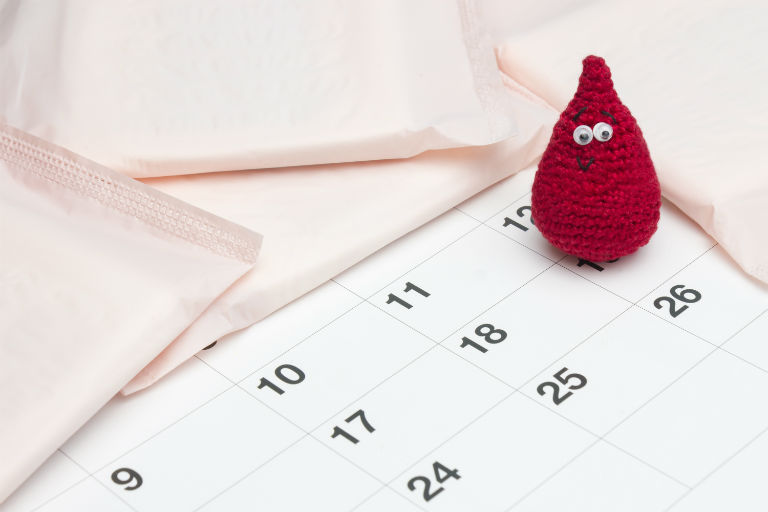
Female Hormone Hacks to Keep Your Period on Track
Let’s face it. Being a girl isn’t always easy. Especially when it comes to that monthly visitor that seems to show up at the most inopportune times. And when she brings her friends that drag down your mood and make you reach for the heating pad and a few Advil, it’s time to make some changes to your choice of company!
How Your Menstrual Cycle Works
Although there are lots of moving parts and a variety of hormones that have multiple job titles, here’s the simple breakdown of how it works. During the first half of your monthly cycle, estrogen, which is produced by your ovaries, will gradually increase until reaches its highest level around day 12. During this time, the follicle, which holds the egg, is bathed in estrogen which helps it mature, becoming stronger and stronger, hopefully ready for fertilization.
At the same time, estrogen is also priming the uterus in preparation for possible implantation by a fertilized egg. In order to have a nice comfy spot for a “maybe baby” to call home, estrogen helps the uterine lining grow, making it thick, spongy and ready to accommodate a growing embryo.
Once the estrogen spike occurs, another hormone is released which does two very distinct things: a) it triggers the release of the egg from the ovary (ovulation) and b) it stimulates the production of progesterone from the corpus luteum which begins the second half of your cycle.
Known as the luteal phase, the final 14 days of the menstrual cycle is when progesterone begins to thicken the uterine lining, ensuring sufficient blood supply to support a growing embryo. If the fallopian tubes deliver an unfertilized egg, the uterine lining begins to slough off and menses begins once again.
Where things begin to break down
Instead of a normal 28-day cycle, some women find themselves having longer (or shorter) cycles which can create unwanted hormonal side effects. When the first half of the cycle is too short, there won’t be enough estrogen to form a healthy follicle or prepare the uterine lining. Conversely, if there is too much estrogen, the lining can overbuild which leads to an excess of uterine tissue causing heavy bleeding and cramping during the cycle.
And as you might expect, the strength and health of the 2nd half (luteal phase) of the cycle is entirely dependent on how well things go during the 1st half or follicular phase of the cycle. So if ovulation doesn’t occur until day 18 (should be on or around day 12), there isn’t enough time for progesterone to prepare the uterine lining for implantation. Mood and energy changes can occur along with disruptions in sleep and food cravings.
If ovulation occurs too early in the cycle, the egg doesn’t have sufficient time to ‘ripen’ under the influence of estrogen which leads to altered and prolonged progesterone during the 2nd half and more unwanted hormonal side-effects.
3 ways to support a normal menstrual cycle
Fortunately, your body has all the tools it needs to do support a normal menstrual cycle. All you have to do is find the kind of support your body needs and then allow your body to reset your hormonal timing so your periods will be a breeze.
1. Be consistently kind to your liver
As your primary filter, the liver also has the job of regulating the hormones that circulate through your body. But the liver can only do so much, especially if the detoxification pathways are all gummed up. The good news is that with a little attention and the right nutrients, your liver can begin filtering out any excess hormones that may be increasing the thickness of the uterine lining and causing other disruptions within your cycle.
Include at least one serving per day of cruciferous vegetables which include broccoli, cauliflower, brussels sprouts, and kale. Spanish black radish, garlic, and onions can also get things moving again. Some of the best herbal choices include schisandra and milk thistle. Once you get the liver detoxification pathways working well, any excess hormones will be a thing of the past.
2. Encourage normal cycle timing
Although it’s easier said than done, making sure your menstrual cycle runs on a 28-day rhythm with 14 days for each phase can improve unpleasant symptoms dramatically. One of the most widely used herbs for the treatment of menstrual-related disorders is chaste tree. This amazing herb helps reduce breast tenderness, supports dopamine and melatonin production, and most importantly, improves normal cycle timing. The herb should contain a sufficient amount of diterpenes, an important phytochemical found in high-quality chaste tree, in order to confer these benefits.
3. Clean up your cosmetics
Your skin will absorb anything you put on it which includes xenohormones found in a large number of cosmetics and body care products. These are added to enhance the way the skin looks and feels, often boasting the reduction of fine lines, promoting smoother skin and being a virtual “fountain of youth.” Despite clever marketing tactics, the hormones contained in these products will wreak havoc on an otherwise normal menstrual cycle. Cosmetic companies are not required to disclose on the label whether the product contains hormones or not so further investigation is required.
If you suspect this might be part of the problem, start by switching out your products. Once you’ve found something cleaner (look for organic skin care products), add in some liver-supportive foods and herbs to help your liver clean up and eliminate these endocrine-disrupting chemicals as quickly as possible!
With the right kind of support and a little time, your menstrual cycle should return to normal within a few months. If you find that it’s not happening as quickly as you want, or you have a more complicated situation, there are other herbs and nutrients that can help correct the underlying issue. Remember that your body is 100% capable of maintaining a normal menstrual cycle, as long as it has the right kinds of food and quality herbs to nudge it along.



